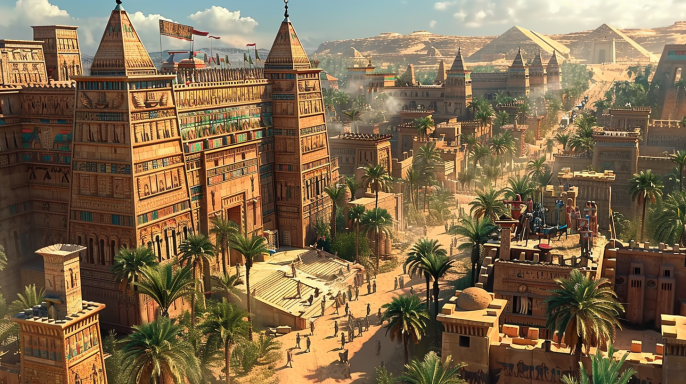Introduction
The Kingdom of Kush, located south of ancient Egypt in present-day Sudan, was a powerful and influential civilization that thrived for over a thousand years. Known for its rich culture, architectural marvels, and formidable rulers, Kush left an indelible mark on history. However, the reasons behind its decline around the 4th century CE remain a subject of speculation and intrigue.
Origins of Kush
The Kingdom of Kush emerged around 2500 BCE, centered in the region of Nubia. This area, strategically located along the Nile River, allowed the Kushites to develop a thriving culture based on agriculture, mining, and trade. Early Kushite society was marked by its complex social structures and sophisticated governance.
Relations with Ancient Egypt
Kush had a long and intricate relationship with ancient Egypt, characterized by periods of both conflict and cooperation. The two civilizations influenced each other significantly, with Kush adopting many aspects of Egyptian culture, religion, and art. The Kushites even ruled Egypt as the 25th Dynasty, known as the Nubian Pharaohs.
The Rise of Kush
Kush rose to prominence as a formidable power, expanding its territory and influence. This period saw significant achievements in governance, architecture, and culture. The kingdom’s capital, Napata, became a center of political and religious life.
The Napatan Period
During the Napatan Period (circa 750-300 BCE), Kushite rulers consolidated their power and expanded their territory. Prominent leaders like King Piye and Taharqa led military campaigns that extended Kushite influence into Egypt and beyond. This era is noted for its flourishing arts and monumental architecture.
The Meroitic Period
Around 300 BCE, the Kushite capital moved to Meroë, marking the beginning of the Meroitic Period. This era was characterized by significant cultural and technological advancements. The development of the Meroitic script and the flourishing of ironworking are notable achievements of this period.
Economy and Trade
The Kingdom of Kush was economically prosperous, with a well-established trade network that extended across Africa and into the Mediterranean. Kushite merchants traded gold, ivory, and other valuable commodities. Agriculture and mining, particularly of gold and iron, were critical to the kingdom’s economy.
Art and Architecture
Kushite art and architecture reflect a unique blend of indigenous and Egyptian influences. The kingdom is renowned for its pyramids, particularly those at Meroë, which, although smaller, are more numerous than their Egyptian counterparts. Temples, palaces, and intricate sculptures also highlight the artistic prowess of the Kushites.
Religious Practices
Religion played a central role in Kushite society. The Kushites worshipped a pantheon of gods, many of which were borrowed from Egyptian mythology, such as Amun and Isis. Temples were built to honor these deities, and religious rituals were integral to daily life and governance.
Powerful Queens and Kings
Kushite history is marked by the reigns of powerful queens and kings. Queens, known as Kandakes or Candaces, held significant political power and often led military campaigns. Kings like Piye and Taharqa are remembered for their ambitious conquests and contributions to the kingdom’s prosperity.
Military Strength
The Kushite military was a formidable force, known for its skilled archers and cavalry. The kingdom’s strategic location and military prowess enabled it to defend its territory and expand its influence. Key battles, particularly against Egyptian forces, showcased the strength and tactical acumen of the Kushite army.
Decline of the Kingdom
Despite its many achievements, the Kingdom of Kush began to decline around the 4th century CE. Several factors contributed to this downfall, including internal strife, economic challenges, and external pressures from neighboring civilizations.
Mysteries Surrounding the Decline
The exact reasons for the decline of Kush remain a mystery. Some theories suggest environmental changes, such as desertification, while others point to political instability and military defeats. The lack of comprehensive historical records from this period leaves many questions unanswered.
Archaeological Discoveries
Archaeological excavations in the region have unearthed significant insights into Kushite civilization. Sites like Meroë and Napata have revealed tombs, temples, and artifacts that shed light on the kingdom’s rich history. These discoveries continue to inform our understanding of Kushite society and culture.
Legacy of the Kingdom of Kush
The Kingdom of Kush has left a lasting legacy on African and world history. Its cultural and architectural contributions influenced subsequent civilizations, and its history is a testament to the complexity and diversity of ancient African societies. Modern scholars and historians continue to study Kush, recognizing its significance in the broader context of ancient history.
Comparison with Other Ancient Civilizations
Kush shares similarities with other contemporary civilizations, such as Egypt and Mesopotamia, in terms of its social structure, religious practices, and architectural achievements. However, its unique blend of indigenous and foreign influences sets it apart, offering valuable lessons on cultural integration and adaptation.
Conclusion
The Kingdom of Kush stands as a powerful testament to the ingenuity and resilience of ancient African civilizations. Despite the mysteries surrounding its decline, Kush’s rich cultural heritage and historical significance endure. Continued research and exploration promise to uncover more about this fascinating kingdom, ensuring that its story remains alive for future generations.
FAQs
What were the main achievements of the Kingdom of Kush?
The Kingdom of Kush is known for its advanced architecture, including numerous pyramids, its development of the Meroitic script, and its influential trade networks.
How did Kush interact with ancient Egypt?
Kush had a complex relationship with Egypt, marked by periods of conflict and cooperation. The Kushites ruled Egypt as the 25th Dynasty and adopted many aspects of Egyptian culture.
Why did the Kingdom of Kush decline?
The decline of Kush is attributed to a combination of factors, including environmental changes, economic challenges, and external pressures. However, the exact reasons remain unclear.
What are some notable archaeological sites in Kush?
Notable archaeological sites in Kush include Meroë, Napata, and Kerma, where significant discoveries of pyramids, temples, and artifacts have been made.
How is the Kingdom of Kush remembered today?
The Kingdom of Kush is remembered for its rich cultural heritage and significant contributions to ancient history. It is studied by historians and celebrated for its achievements and influence.

